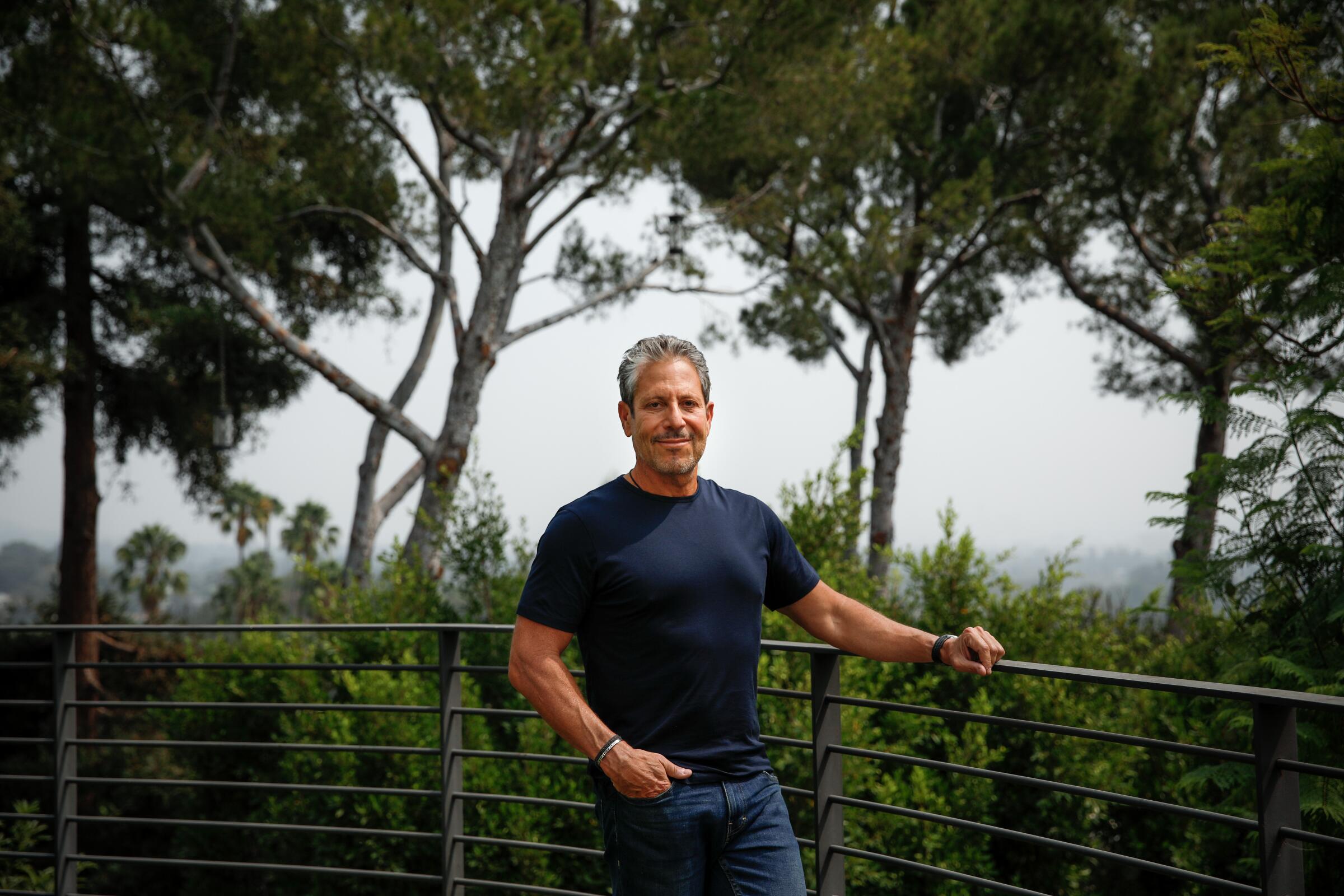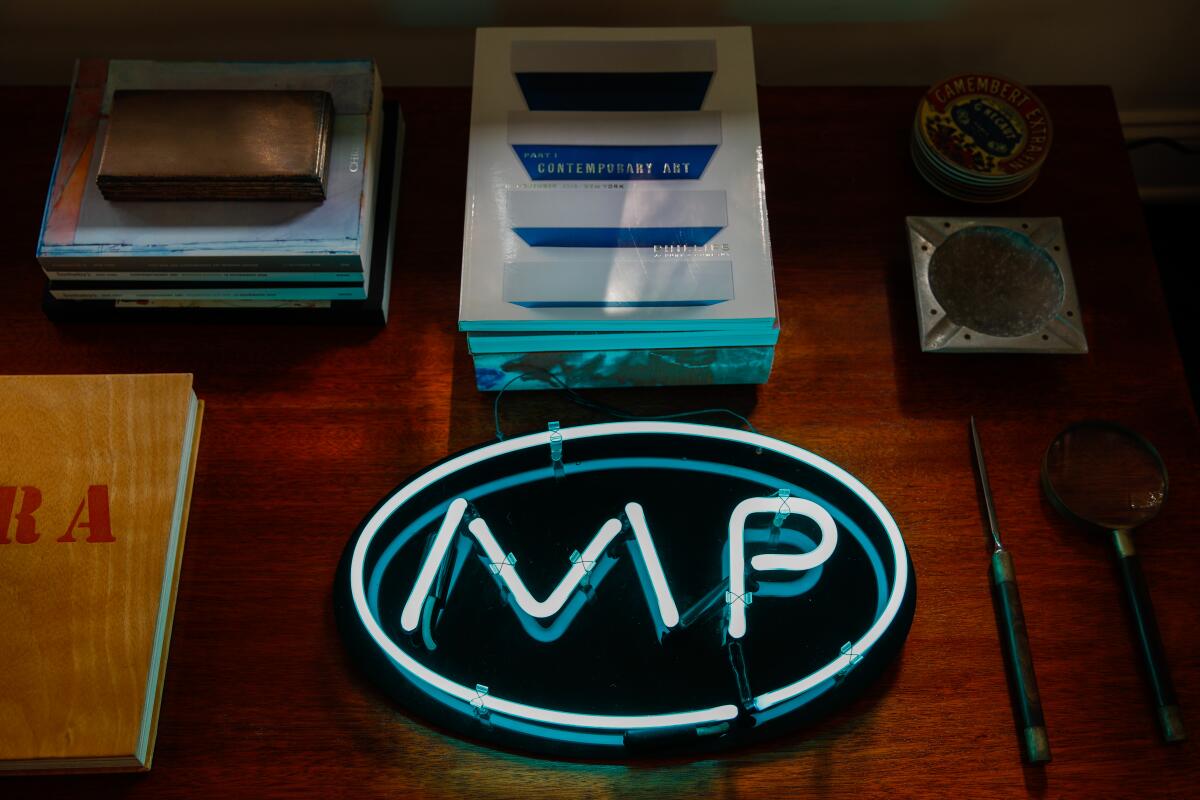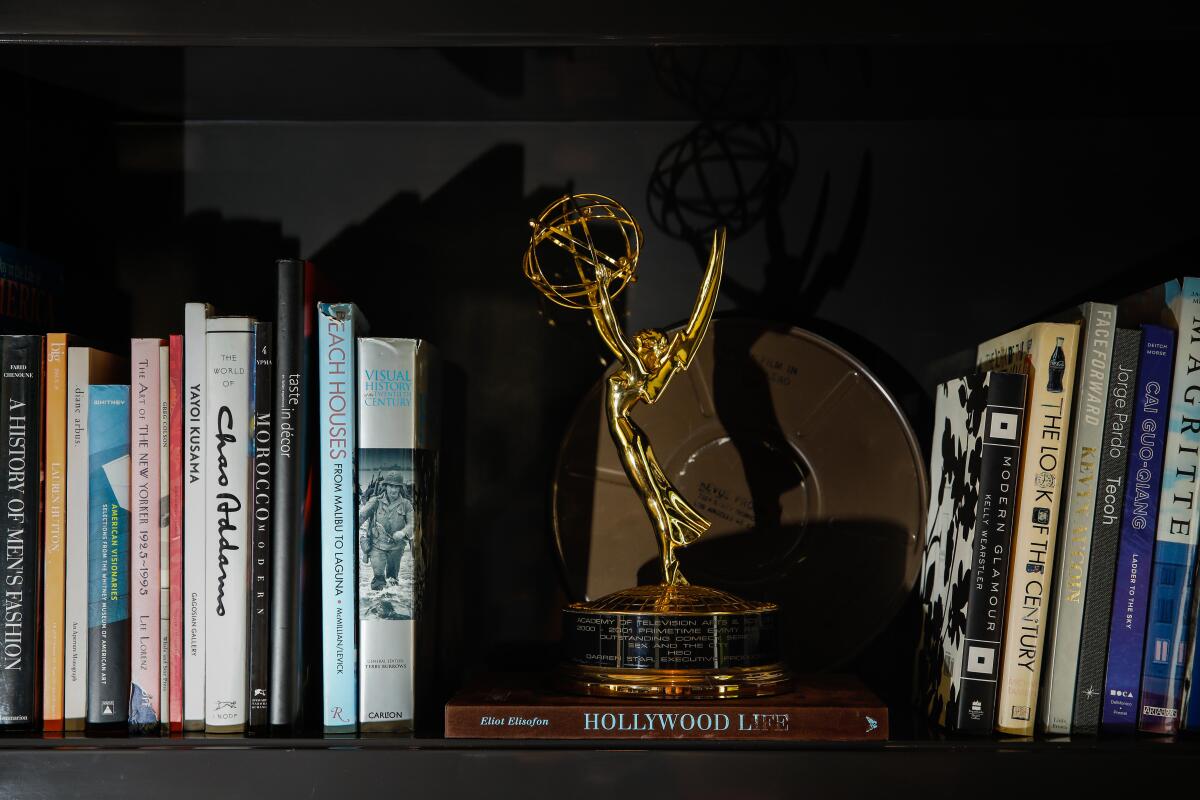The complete guide to home viewing
Get Screen Gab for everything about the TV shows and streaming movies everyone’s talking about.
You may occasionally receive promotional content from the Los Angeles Times.

When Darren Star, the creator behind hits like “Beverly Hills, 90210” and “Sex and the City,” has his characters roam Paris (or a backlot disguised as it), it’s not usually for long. “90210’s” Brenda and Donna had a brief stay the summer before their senior year in high school, while “Sex and the City’s” Carrie Bradshaw had a short fling with the City of Light after following her Russian artist boyfriend there.
But “Emily in Paris,” Star’s latest creation, is the first to be set there.
Available to stream beginning Friday, the 10-episode half-hour comedy revolves around Emily Cooper (Lily Collins), a spunky American marketing executive who moves to Paris after falling into a job modernizing the social media strategy of a French luxury marketing company her employer has acquired. When she’s not trying to win over her skeptical colleagues, Emily develops her own social media following documenting her new American-girl-in-Paris persona in all its fashionable, croissant-eating glory.
To kick off our 2020 fall TV preview, the Times TV team selects the 15 shows we’ll be watching this fall — and that you should be watching too.
It joins Star’s oeuvre of aspirational TV shows, which includes “Melrose Place” and “Younger.”
From his Bel-Air home, the 59-year-old producer spoke over Zoom about the inspiration for “Emily in Paris,” the one regret in his career in television, and his thoughts on ending “Younger.” Oh, and as for whether Carrie Bradshaw would be a pandemic baker — as actress Sarah Jessica Parker recently suggested to Entertainment Weekly, eliciting skepticism from some fans — Star says, “I can see her baking. That’s, perhaps, Carrie today. I could also see her drinking. She’d be doing a lot of reading.” The interview has been edited for clarity and condensed.

After racking up a catalog of shows that have paid homage to Los Angeles and New York, Star set his sights on Paris. The series was shot entirely on location in Paris and throughout France. And, he says, there’s an autobiographical element to its premise.
I was a bit of a French geek as a kid. I took French from elementary school to college and I went to Paris by the time I was 19, backpacking in Europe, and then I’d go back as often as I could. I always dreamed about what it’d be like to work and live there. So, that’s sort of where the genesis of the show came from — it’s sort of my experiences having been there. I rented an apartment there for a number of months to sort of step into the shoes of the character. And I just really wanted to share my love of Paris and France but also explore the sort of cultural differences that do exist and have some fun with that. And also do a show there — because TV has gotten to a place where you can actually go and film a series in Paris. I think of it as a big romantic comedy on steroids.
In a way, a show like “Emily in Paris,” even though it’s about a girl in her 20s, it’s personal because it scratched an itch for me. I think whatever project I do, if I’m writing it, it has to scratch an itch; I have to be learning something from it. “Younger,” to me, was like, I knew these women who left the workplace and then found it hard after raising a family to get back to work. Beyond that, I was really curious about just millennial culture, and suddenly I found myself on the other end — that I was suddenly, after being the young guy in the room, I was the older generation.
In the series, Emily chronicles her adventures in Paris on her Instagram account with punny captions and enviable backdrops.
It’s sort of a way she keeps her journal, and she unintentionally becomes an influencer through sharing her life in Paris. She’s there because she’s overseeing social media, so it is like her area of expertise. And I did want to talk about this idea of taste — this objective and subjective idea of taste, and what it means to define taste and how the French have defined taste, and how a French marketing firm that she works for, with these more luxury goods, defines what good taste is. And Instagram sort of democratizes taste and basically says: “No, we don’t need gatekeepers. All of us are those gatekeepers.”
In uncertain times, TV series like “Younger” are turning the romantic comedy on its head, rejecting notions like “happily ever after” and “one true love.”
Star recently announced that he’s conceiving “Younger’s” upcoming seventh season as its last. The dramedy, which introduced viewers to Sutton Foster’s Liza — a 40-year-old single mother posing as a 26-year-old to get an entry-level job in publishing — wrapped its sixth season on TV Land last fall and had to postpone production in New York City on its seventh season because of the pandemic. Filming of the new season is slated to begin later this month.
It’s not anybody telling us we have to [end] it. It’s more a sense of feeling like it’ll have been seven seasons and the themes of the show have been explored and it gets to the point where, “Well, now we just all love these characters” — so we just want to keep telling stories for these characters? And yes, that is possible. But I feel like to maintain the relevance of the show, at a certain point you want to leave when it still feels like you have something to say.
I do think there’s more on network television — not so much premium — this idea that, let’s just get the show going forever and ever and ever. And it just becomes about, “Are ratings enough to keep the show on the air?” — not creatively thinking, “Is it a good idea to keep the show in there?”
We talked a lot about things before the virus hit and now we’re talking about things a little differently after the virus hit. Even in the pre-coronavirus world of this show, these characters have changed. They’ve gotten older. And Liza doesn’t have a secret anymore. There’s been so much growth in all of the characters that it’s about, “How do we tell a satisfying ending that’s true to their lives and we feel like we’re going out on a high note?” We’re still debating it. We’re in the writers’ room now ... on Zoom.
We might have some final words in mind already. If we can get there, we have some good thoughts in mind for some final scenes.
Star was 27 — with only one screenplay to his name — when he was approached by then-newbie network Fox to pitch an idea that could fit its ambitions for a show set at a Beverly Hills high school, which Aaron Spelling was on board to produce. Premiering in 1990, the prime-time teen soap initially sputtered in the ratings before becoming an icon of the genre. The property has been so enduring it’s spawned a sequel, with a new cast of teenagers and parents, on the CW in 2008; a made-for-television movie on Lifetime about the behind-the-scenes drama that played out during the run of the show; and last year’s Fox reboot featuring most of the show’s original cast members.
Sunday marks the 30th anniversary of the show’s debut.
I don’t rewatch it. I did rewatch one episode for a podcast that I was asked to do and I kind of thought, “Wow, that’s not bad.” I actually couldn’t remember writing it — I think it was the “Slumber Party” episode. I remember seeing that in the editing room and thinking, “Well, if I were just a teenager watching this, I’d find it hard to change the channel.”
The new “90210” is not your usual reboot. The stars share their thoughts on how “BH90210” compares with “Beverly Hills, 90210.”
I had Aaron Spelling behind me and he really believed in me, and was a fantastic mentor. He gave me a wide berth from the beginning of the pilot — I was part of casting and editing and everything. The amount of work just keeps you so grounded and focused that, as the show blew up, we were just all focused on getting out the next episode. The first season we did 22, the next season we did 28, then I did “Melrose Place” at the end of the second season. So there wasn’t really time to enjoy it. I was really pleased that it was successful because at the beginning it wasn’t. We were hanging on by a thread, and I remember Aaron Spelling calling the network and saying, “Just four more episodes, guys, just four more episodes.” He was relentless about that.
Star says he’s most often asked by fans who he thinks Dylan ended up with — Brenda or Kelly?
I think Brenda. To me, they’re the O.G. couple and their chemistry was amazing.

In the Season 2 finale of “Melrose Place,” there was supposed to be a scene that showed its openly gay character, Matt Fielding (Doug Savant), kiss another man after their first date. The moment had been filmed but when the episode aired in May 1994, the kiss had been removed — all viewers saw was the two men shake hands and exchange a meaningful gaze. Keeping it in the episode is the one revision in his storied television career that he would make.
I felt like we were always pushing [boundaries] — it’s hard to imagine now, that that was such an issue and controversy. I think that’s the only thing that I, regrettably, feel like I wish we could go back and put the footage back in that was shot. We would deliver it to the network and say, “We’re not cutting this. You guys are making a cut. If you can’t see two men kissing, that’s your call, but we’re not making that. We’re not censoring ourselves.” We were all thinking how important it was just to actually be able to see that on a show that’s popular. That was a frustration. We did fight the battle as hard as we could.
It’s partly why I wanted to do a show like “Sex and the City” and be at HBO and not have any of those guardrails about content. At a certain point you feel like you’re just writing for an artificial world. And I also had a theory about TV — it’s always 20 years behind culture. It’s weird to think of it now, just how censored TV has always been, network television. Going back to “The Dick Van Dyke Show” or “I Love Lucy,” when characters, a married couple, couldn’t sleep in the same bed.

Following the success of “Beverly Hills, 90210” and “Melrose Place,” Star set out on his first network series without Spelling for CBS with the 1995 TV drama “Central Park West” — later revamped as “C.P.W.” The short-lived series followed the young staff of a glossy magazine. It was the show, he says, that yielded one of the more bizarre network notes he’s been given.
Les Moonves stepped in as the head of CBS and we were halfway through filming the season, and we were casting a love interest for Mädchen Amick, who was, at the time, in her 20s. And the big idea that came down from on high was Gerald McRaney. I’m like, “Gerald McRaney?” And then I realized they didn’t want it to be a young show anymore. They wanted it to be a show to suddenly hit the older CBS audience because they didn’t really have a young audience at CBS to watch or find a show. So they’re like, “We just want Gerald McRaney on the show. We don’t care how it happens, we just want him on the show.” So actually, we found a great role for Gerald McRaney, a sort of a Ted Turner-like character. And then Raquel Welch was on the show and then it was like, the show basically became a different show. And that was my farewell to network television for a while, because I did “Sex and the City” after that. So it was head-spinning.
And I think in hindsight, I should have just said, “I quit. It’s not the show that I set out to do and it’s not the show we agreed on. Let’s just call it a day.” But we ended up doing 22 episodes and somehow, it only got cut down to 16. It was really one of those nightmare network experiences. And I think, certainly, the show paid the price because those things, it never works. If you’re not following your instinct, it never works.
‘Emily in Paris’
Where: Netflix
When: Anytime, starting Friday
Not rated
The complete guide to home viewing
Get Screen Gab for everything about the TV shows and streaming movies everyone’s talking about.
You may occasionally receive promotional content from the Los Angeles Times.